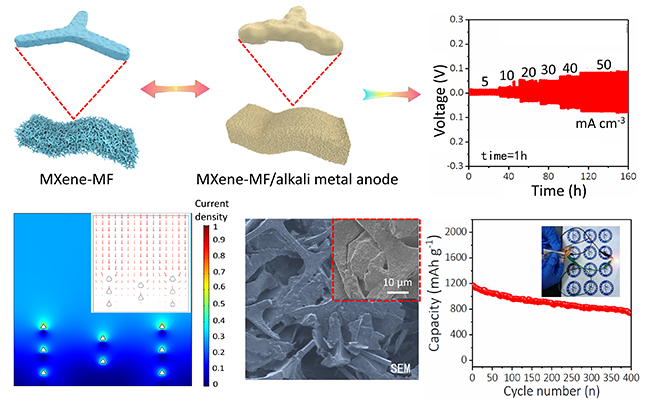Alkali-metal anodes are considered as ideal anodes for high-energy-density batteries due to their high theoretical capacities and low redox potential.
However, the undesirable growth of dendrite and infinite relative change of volume during cycling processes have blocked the commercialization of alkali-metal anodes.
Researchers led by Prof. WU Zhongshuai in collaboration with Prof. LI Xianfeng, Dr. ZHENG Qiong from the Dalian Institute of Chemical Physics (DICP) of the Chinese Academy of Sciences, and Prof. YU Yan from University of Science and Technology of China, developed flexible three-dimensional (3D) MXene/Melamine foam (MXene-MF) with high electronic conductivity for alkali-metal anode with ultrahigh current density and capacities.
The study was published in ACS Nano on June 12.
The scientists took advantages of high conductivity and lithiophilic surfaces from MXene, in combination of porous, lightweight and flexible nature from 3D MF to develop the MXene-MF.
It possessed 3D interconnected porous conductive network and showed good mechanical flexibility and strength, enabling a highly dense and homogenous alkali-metal deposition and suppressing volume fluctuation at both high current density and deposition capacity. Consequently, it achieved a high current density of 50 mA/cm2 for 50 mAh/cm2 for Li anode, and realized a high areal deposition capacity of 20 mAh/cm2 for Na anode.
Theoretical simulation demonstrated that the MXene-MF electrode could significantly reduce current density and guide the lithium ions deposition on the MXene skeleton. Moreover, such a robust 3D architecture guaranteed the repeated cycling without decomposing the structural integrity.
By pairing MXene-MF-Li with sulfur and MXene-MF-Na with Na3V2(PO4)3, respectively, the assembled full-batteries showed improved cycling and rate capability. MXene-MF is promising in constructing high-energy-density batteries.

Schematic of 3D MXene-MF foam for high current-density, high-capacity alkali-metal anodes (Image by SHI Haodong and HOU Xiaocheng)
The study was supplied by National Natural Science Foundation of China, National Key R&D Program of China, Dalian National Laboratory For Clean Energy (DNL), CAS. (Text by SHI Haodong and HOU Xiaocheng)